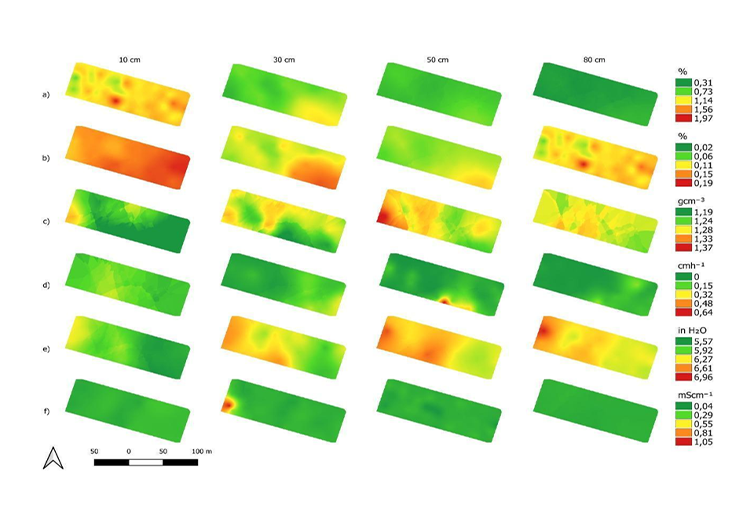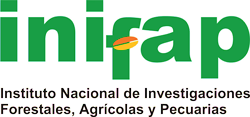Variabilidad de carbono en el suelo de un arrozal en Costa Rica
DOI:
https://doi.org/10.29312/remexca.v16i5.3664Palabras clave:
interpolación geoestadística, mapeo de suelos, método Kriging, mitigación del cambio climático.Resumen
El conocimiento del reservorio de carbono del suelo (RCS) es vital para la gestión de prácticas agrícolas apropiadas, como la labranza y para el monitoreo en los cambios en el RCS en proyectos relacionados con la mitigación de la huella de carbono. El objetivo de este estudio es cuantificar la variabilidad y distribución espacial del reservorio de carbono del suelo. En el año 2019, en 1 ha se realizaron 45 micro-calicatas (1 x 0.8 x 1 m) y se analizaron cuatro estratos. Se cuantificó la distribución vertical del carbono y otras propiedades químicas y físicas del suelo que afectan la producción de arroz en Parrita, Costa Rica. Se elaboró un mapa de predicción espacial de la distribución del carbono y se estimó la efectividad de la predicción del reservorio de carbono del suelo cuando se utilizan diferentes cantidades de puntos de muestreo: 45, 27, 15 y 7. Como medidas de precisión, se calculó el error absoluto medio y el error cuadrático medio. El reservorio de carbono del suelo en el perfil total (0-100 cm) fue de 85.8 (±2.6) Mg C ha-1, donde los primeros 30 cm representaron el 46.2% del C total. La predicción de la distribución espacial sugiere que, en cultivos agrícolas anuales con sistemas de labranza, 15 puntos ha-1 pueden estimar efectivamente el reservorio de carbono del suelo.
Descargas
Citas
Aguilera, E.; Lassaletta, L.; Gattinger, A. and Gimeno, B. S. 2013. Managing soil carbon for climate change mitigation and adaptation in mediterranean cropping systems: a meta-analysis. Agriculture, Ecosystems and Environment. 168:25-36. https://doi.org/10.1016/j.agee.2013.02.003.
Ahmed, I. S.; Hassan, F. A.; Sulieman, M. M.; Keshavarzi, A.; Elmobarak, A. A.; Yousif, K. M. and Brevik, E. C. 2022. Using environmental covariates to predict soil organic carbon stocks in Vertisols of Sudan. Geoderma Regional. 31(e00578):1-16. https://doi.org/10.1016/j.geodrs.2022.e00578.
Alvarado-Velas, M.; Monge-Cordero, M.; Arias-Fernández, M.; Chinchilla-Cortés, J.; Briones-Cambronero, K.; and Alfaro-Martínez, A. 2021. Estudio hidrogeológico de los acuíferos del Pacífico Central, provincias de Puntarenas y San José, Costa Rica, América Central (Informe técnico). Dirección de Investigación y Gestión Hídrica, Unidad de Investigación Hidrogeológica. SENARA. 12-246 pp.
Anantha, K. C.; Majumder, S. P.; Padhan, D.; Badole, S.; Datta, A.; Mandal, B. and Gade, K. R. 2018. Carbon dynamics, potential and cost of carbon sequestration in double rice cropping system in semiarid southern India. Journal of Soil Science and Plant Nutrition. 18(2):418-434. https://doi.org/10.4067/S0718-95162018005001302.
Augustin, C. and Cihacek, L. J. 2016. relationships between soil carbon and soil texture in the northern great plains. Soil Science. 181(8):386-392. Doi: https://doi.org/10.1097/SS.0000000000000173.
Averill, C. and Waring, B. 2018. Nitrogen limitation of decomposition and decay: How can it occur?. Global Change Biology. 24(4):1417-1427. https://doi.org/10.1111/gcb.13980.
Bhunia, G. S.; Shit, P. K. and Maiti, R. 2018. Comparison of GIS-based interpolation methods for spatial distribution of soil organic carbon (SOC). Journal of the Saudi Society of Agricultural Sciences. 17(2):114-126. https://doi.org/10.1016/j.jssas.2016.02.001.
Bogunovic, I.; Kisic, I.; Mesic, M.; Percin, A.; Zgorelec, Z.; Bilandžija, D.; Jonjic, A. and Pereira, P. 2017. Reducing sampling intensity in order to investigate spatial variability of soil pH, organic matter and available phosphorus using co-kriging techniques. A case study of acid soils in Eastern Croatia. Archives of Agronomy and Soil Science. 63(13):1852-1863. https://doi.org/10.1080/03650340.2017.1311013.
Börjesson, G.; Bolinder, M. A.; Kirchmann, H. and Kätterer, T. 2018. Organic carbon stocks in topsoil and subsoil in long-term ley and cereal monoculture rotations. Biology and Fertility of Soils. 54(4):549-558. https://doi.org/10.1007/s00374-018-1281-x.
Chacón, P.; Lorenz, K.; Lal, R.; Calhoun, F. G. and Fausey, N. 2015. Soil organic carbon in some land uses of Costa Rica. Acta Agriculturae Scandinavica Section B: soil and Plant Science. 65(4):310-320. https://doi.org/10.1080/09064710.2015.1008563.
Chatterjee, N.; Nair, P. K.; Nair, V. D.; Bhattacharjeem, A.; Virginio-Filho, E. M.; Muschler, R. G. and Noponen, M. R. A. 2020. Do coffee agroforestry systems always improve soil carbon stocks deeper in the soil? a case study from Turrialba, Costa Rica. Forests. 11(1):1-49. https://doi.org/10.3390/f11010049.
Chen, X.; Hu, Y.; Xia, Y.; Zheng, S. ; Ma, C.; Rui, Y.; He, H.; Huang, D.; Zhang, Z.; Ge, T.; Wu, J.; Guggenberger, G.; Kuzyakov, Y. and Su, Y. 2021. Contrasting pathways of carbon sequestration in paddy and upland soils. Global Change Biology. 27(11):2478-2490. https://doi.org/10.1111/gcb.15595.
Davis, M.; Alves, B. J.; Karlen, D. L.; Kline, K. L.; Galdos, M. and Abulebdeh, D. 2018. Review of soil organic carbon measurement protocols: a US and Brazil comparison and recommendation. Sustainability. 10(1):1-20. https://doi.org/10.3390/su10010053.
FAO. 2019. Food and Agriculture Organization of the United Nations. Recarbonization of global soils. A dynamic response to offset global emissions. http://www.fao.org/3/i7235en/I7235EN.pdf. 1-8 pp.
FAO. 2020. Food and Agriculture Organization of the United Nations. A protocol for measurement, monitoring, reporting and verification of soil organic carbon in agricultural landscapes GSOC-MRV Protocol. Rome. https://doi.org/10.4060/cb0509en.
FAO. 2022. Food and Agriculture Organization of the United Nations. Global Soil Organic Carbon Sequestration Potential Map GSOCseq v.1.1. Technical report. Rome. https://doi.org/10.4060/cb9002en.
FAO. 2024. Food and Agriculture Organization of the United Nations. Cómo la iniciativa RECSOIL impulsa el cambio en Costa Rica. FAO Global Soil Partnership. https://www.fao.org/global-soil-partnership/resources/highlights/detail/es/c/1680245/.
Gregory, A. S.; Dungait, J. A. J.; Watts, C. W.; Bol, R.; Dixon, E. R.; White, R. P. and Whitmore, A. P. 2016. Long-term management changes topsoil and subsoil organic carbon and nitrogen dynamics in a temperate agricultural system. European Journal of Soil Science. 67(4):421-430. https://doi.org/10.1111/ejss.12359.
Jandl, R.; Rodeghiero, M.; Martinez, C.; Cotrufo, M. F.; Bampa, F.; Wesemael, B.; Harrison, R. B.; Guerrini, I. A.; Richter, D. D.; Rustad, L.; Lorenz, K.; Chabbi, A. and Miglietta, F. 2014. Current status, uncertainty and future needs in soil organic carbon monitoring. Science of the Total Environment. 468-469:376-383 pp. Doi:10.1016/j.scitotenv.2013.08.026.
Lal, R. 2016. Beyond COP21: potential and challenges of the ‘4 per Thousand’ initiative. Journal of Soil and Water Conservation. 71. 20A-25A pp. https://doi.org/10.2489/jswc.71.1.20A.
Lawrence, P. G.; Roper, W.; Morris, T. F. and Guillard, K. 2020. Guiding soil sampling strategies using classical and spatial statistics: a review. Agronomy Journal. 112(1):493-510. https://doi.org/10.1002/agj2.20048.
Li, C.; Wang, G.; Han, Q.; Sun, J.; Ning, H. and Feng, D. 2023. Soil moisture and water-nitrogen synergy dominate the change of soil carbon stock in farmland. Agricultural Water Management. 287(1):108-424. https://doi.org/10.1016/j.agwat.2023.108424.
Li, Q.; Li, A.; Dai, T.; Fan, Z.; Luo, Y.; Li, S.; Yuan, D.; Zhao, B.; Tao, Q.; Wang, C.; Li, B.; Gao, X.; Li, Y.; Li, H. and Wilson, J. P. 2020. Depth-dependent soil organic carbon dynamics of croplands across the Chengdu plain of China from the 1980s to the 2010s. Global Change Biology. 26(7):4134-4146. https://doi.org/10.1111/gcb.15110.
Matus, F. J. 2021.Fine silt and clay content is the main factor defining maximal C and N accumulations in soils: a meta-analysis. Sci. Rep. 11(6438):1-17. https://doi.org/10.1038/s41598-021-84821-6.
Nayak, A. K.; Rahman, M. M.; Naidu, R.; Dhal, B.; Swain, C. K.; Nayak, A. D.; Tripathi, R.; Shahid, M.; Islam, M. R. and Pathak, H. 2019. Current and emerging methodologies for estimating carbon sequestration in agricultural soils: a review. Science of the Total Environment. 665:890-912. https://doi.org/10.1016/j.scitotenv.2019.02.125.
Oliveira, D. D.; Paustian, K.; Davies, C. A.; Cherubin, M. R.; Franco, A. L.; Cerri, C. C. and Cerri, C. E. 2016. Soil carbon changes in areas undergoing expansion of sugarcane into pastures in south-central Brazil. Agriculture, Ecosystems and Environment. 228:38-48. https://doi.org/10.1016/j.agee.2016.05.005.
Ojeda, J. J.; Caviglia, O. P. and Agnusdei, M. G. 2018. Vertical distribution of root biomass and soil carbon stocks in forage cropping systems. Plant and Soil. 423(1-2):175-191. https://doi.org/10.1007/s11104-017-3502-8.
RStudio Team. 2020. RStudio: integrated development environment for R (Version 1.3.1093) [Computer software]. RStudio, PBC. https://www.rstudio.com/.
Sherman, L. A. and Brye, K. R. 2019. Soil chemical property changes in response to long‐term pineapple cultivation in Costa Rica. Agrosystems, Geosciences and Environment. 2(1):1-9. https://doi.org/10.2134/age2019.07.0052.
Schloeder, C. A.; Zimmerman, N. E. and Jacobs, M. J. 2001. Comparison of methods for interpolating soil properties using limited data. Soil Science Society of America Journal. 65(2):470-479. https://doi.org/10.2136/sssaj2001.652470x.
Smith, P.; Soussana, J.; Angers, D.; Schipper, L.; Chenu, C.; Rasse, D. P.; Batjes, N. H.; Egmond, F.; McNeill, S.; Kuhnert, M.; Arias‐Navarro, C.; Olesen, J. E.; Chirinda, N.; Fornara, D.; Wollenberg, E.; Álvaro‐Fuentes, J.; Sanz‐Cobena, A. and Klumpp, K. 2020. How to measure, report and verify soil carbon change to realize the potential of soil carbon sequestration for atmospheric greenhouse gas removal. Global Change Biology. 26(1):219-241. https://doi.org/10.1111/gcb.14815
Tautges, N. E.; Chiartas, J. L.; Gaudin, A. C. M.; O’Geen, A. T.; Herrera, I. and Scow, K. M. 2019. Deep soil inventories reveal that impacts of cover crops and compost on soil carbon sequestration differ in surface and subsurface soils. Global Change Biology. 25(11):3753-3766. https://doi.org/10.1111/gcb.14762.
Usowicz, B. and Lipiec, J. 2021. Spatial variability of saturated hydraulic conductivity and its linkswith other soil properties at the regional scale. Scientific Reports. 11(1):1-12.https://doi.org/10.1038/s41598-021-86862-3.
Valderrama-López, C. F.; Castillo-Vargas, J. A.; Torres-Romero, J. C.; Guzmán-Lenis, A. R.; Forero-Ausique, V. F.; Duque-Chaves, C. M.; Sepúlveda-Casadiego, Y. A.; Montenegro-Gómez, S. P. 2018. Capítulo 6. Secuestro y almacenamiento de carbono: capturas de carbono por pagos de servicios ambientales. Escuela de Ciencias Agrícolas, Pecuarias y del Medio Ambiente. Universidad Nacional Abierta y a Distancia. 106-117 pp.
Wen, W.; Wang, Y.; Yang, L.; Liang, D.; Chen, L. D.; Liu, J. and Zhu, A. X. 2015. Mapping soil organic carbon using auxiliary environmental covariates in a typical watershed in the loess plateau of China: a comparative study based on three kriging methods and a soil land inference model (SoLIM). Environ Earth Sci. 73:239-251. https://doi.org/10.1007/s12665-014-3518-9.
Wu, H.; Zheng, X. Zhou, L. and Meng, Y. 2024. Spatial autocorrelation and driving factors of carbon emission density of crop production in China. Environ Sci Pollut Res. 31:27172-27191. https://doi.org/10.1007/s11356-024-32908-8.
Xu, S. Q.; Zhang, M. Y.; Zhang, H. L.; Chen, F.; Yang, G. L. and Xiao, X. P. 2013. Soil organic carbon stocks as affected by tillage systems in a double-cropped rice field. Pedosphere. 23(5):696-704. https://doi.org/10.1016/S1002-0160(13)60062-4.
Yu, H.; Zha, T.; Zhang, X. and Ma, L. 2019. Vertical distribution and influencing factors of soil organic carbon in the loess plateau, China. Science of The Total Environment. 693:133632. https://doi.org/10.1016/j.scitotenv.2019.133632.
Zhong, Z.; Chen, Z.; Xu, Y.; Ren, C.; Yang, G.; Han, X.; Ren, G. and Feng, Y. 2018. Relationship between soil organic carbon stocks and clay content under different climatic conditions in Central China. Forests. 9(10):1-14. https://doi.org/10.3390/f9100598.
Zomer, R. J.; Bossio, D. A.; Sommer, R. and Verchot, L. V. 2017. Global sequestration potential of increased organic carbon in cropland soils. Scientific Reports. 7(15554):1-8. https://doi.org/10.1038/s41598-017-15794-8.

Descargas
Publicado
Cómo citar
Número
Sección
Licencia
Derechos de autor 2025 Revista Mexicana de Ciencias Agrícolas

Esta obra está bajo una licencia internacional Creative Commons Atribución-NoComercial 4.0.
Los autores(as) que publiquen en Revista Mexicana de Ciencias Agrícolas aceptan las siguientes condiciones:
De acuerdo con la legislación de derechos de autor, Revista Mexicana de Ciencias Agrícolas reconoce y respeta el derecho moral de los autores(as), así como la titularidad del derecho patrimonial, el cual será cedido a la revista para su difusión en acceso abierto.
Los autores(as) deben de pagar una cuota por recepción de artículos antes de pasar por dictamen editorial. En caso de que la colaboración sea aceptada, el autor debe de parar la traducción de su texto al inglés.
Todos los textos publicados por Revista Mexicana de Ciencias Agrícolas -sin excepción- se distribuyen amparados bajo la licencia Creative Commons 4.0 atribución-no comercial (CC BY-NC 4.0 internacional), que permite a terceros utilizar lo publicado siempre que mencionen la autoría del trabajo y a la primera publicación en esta revista.
Los autores/as pueden realizar otros acuerdos contractuales independientes y adicionales para la distribución no exclusiva de la versión del artículo publicado en Revista Mexicana de Ciencias Agrícolas (por ejemplo incluirlo en un repositorio institucional o darlo a conocer en otros medios en papel o electrónicos) siempre que indique clara y explícitamente que el trabajo se publicó por primera vez en Revista Mexicana de Ciencias Agrícolas.
Para todo lo anterior, los autores(as) deben remitir el formato de carta-cesión de la propiedad de los derechos de la primera publicación debidamente requisitado y firmado por los autores(as). Este formato debe ser remitido en archivo PDF al correo: revista_atm@yahoo.com.mx; revistaagricola@inifap.gob.mx.
Esta obra está bajo una licencia de Creative Commons Reconocimiento-No Comercial 4.0 Internacional.


